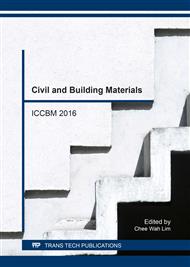[1]
Maravelaki-Kalaitzaki P, Bakolas A. Moropoulou physico-chemical study of Cretan ancient mortars. Cem Concr Res 2003; 33: 651–61.
DOI: 10.1016/s0008-8846(02)01030-x
Google Scholar
[2]
G. Cultrone, E. Sebastián, M. Ortega Huertas. Forced and natural carbonation of lime-based mortars with and without additives: Mineralogical and textural changes. Cement and Concrete Research 35 (2005) 2278– 2289.
DOI: 10.1016/j.cemconres.2004.12.012
Google Scholar
[3]
G. Margalha, R. Veiga, A.S. Silva, J. Brito, Traditional methods of mortar preparation: the hot lime mix method, Cem. Concr. Compos. 33 (2011) 796–804.
DOI: 10.1016/j.cemconcomp.2011.05.008
Google Scholar
[4]
P. Maravelaki-Kalaitzaki, A. Bakolas, I. Karatasios, V. Kilikoglou, Hydraulic lime mortars for the restoration of historic masonry in Crete, Cem. Concr. Res. 35 (8) (2005) 1577–1586.
DOI: 10.1016/j.cemconres.2004.09.001
Google Scholar
[5]
T. Cerulli, C. Pistolesi, C. Maltese, D. Salvioni, Durability of traditional plasters withrespect to blast furnace slag-based plaster, Cem. Concr. Res. 33 (2003) 1375–1383.
DOI: 10.1016/s0008-8846(03)00072-3
Google Scholar
[6]
M. Lanzón-Torres, P.A. García-Ruiz, Lightweight puzzolanic materials used in mortars: evaluation of their influence on density, mechanical strength and water absorption, Cem. Concr. Compos. 31 (2009) 114–119.
DOI: 10.1016/j.cemconcomp.2008.11.003
Google Scholar
[7]
M. Arandigoyen, J.L. Pérez-Bernal, M.A. Bello-López, J.I. Alvarez, Lime-pastes with different kneading water: Pore structure and capillary porosity, Appl. Surf. Sci. 252 (2005) 1449–1459.
DOI: 10.1016/j.apsusc.2005.02.145
Google Scholar
[8]
P. Faria, F. Henriques, V. Rato, Comparative evaluation of lime mortars for architectural conservation, J. Cult. Herit. 9 (2008) 338–346.
DOI: 10.1016/j.culher.2008.03.003
Google Scholar
[9]
J. Lanas, J.L. Perez Bernal, M.A. Bello, J.I. Alvarez, Mechanical properties of masonry repair dolomitic lime-based mortars, Cem. Concr. Res. 36 (5) (2006) 951–960.
DOI: 10.1016/j.cemconres.2005.10.004
Google Scholar
[10]
M.P. Seabra, H. Paiva, J.A. Labrincha, V.M. Ferreira, Admixtures effect on fresh state properties of aerial lime based mortars, Constr. Build. Mater. 23 (2009) 1147–1153.
DOI: 10.1016/j.conbuildmat.2008.06.008
Google Scholar
[11]
B. Johannesson, P. Utgenannt, Microstructural changes caused by carbonation of cement mortar, Cem. Concr. Res. 31 (2001) 925–931.
DOI: 10.1016/s0008-8846(01)00498-7
Google Scholar
[12]
Robert M. Lawrence, Timothy J. Mays, Sean P. Rigby, Peter Walker, Dina D´ Ayala. Effects of carbonation on the pore structure of non-hydraulic lime mortars, Cement and Concrete Research 37 (2007) 1059–1069.
DOI: 10.1016/j.cemconres.2007.04.011
Google Scholar
[13]
M. Arandigoyen, J.I. Alvarez, Carbonation process in lime pastes with different wáter/binder ratio. Construction materials, vol. 56, 281, 5-18. January- March 2006. ISSN 0465-2746.
DOI: 10.3989/mc.2006.v56.i281.88
Google Scholar
[14]
S. Peroni, C. Tersigni, G. Porraca, S. Cerea, M. Forti, F. Guidobaldi, P. Rossi-Doria, A. De Rege, D. Picci, F.J. Pietrafitta, G. Benedetti, Lime based mortars for the repair of ancient masonry and possible substitutes, mortars, cements and grouts used in the conservation of historic buildings Symposium 3–6/11/1981, ICCROM, Rome, 1981, p.63.
Google Scholar
[15]
Askeland, Donald., La Ciencia E Ingeniería De Los Materiales. Editorial Thomson-México. ISBN 13: 9789706863614. Año (2004).
Google Scholar
[16]
Norma ASTM C109/109M-02, Standard Test Method for Compressive Strength of Hydraulic Cement Mortars (Using 2-in. or [50-mm] Cube Specimens).
DOI: 10.1520/c0109_c0109m-20
Google Scholar
[17]
Norma ASTM C348-02, Historical Standard: ASTM C348-02 Standard Test Method for Flexural Strength of Hydraulic-Cement Mortar.
Google Scholar
[18]
Navarro Sánchez L. M., Martínez Molina W., Espinoza Mandujano A., Análisis de Materiales. Segunda edición, Facultad de Ingeniería Civil. Universidad Michoacana de San Nicolás de Hidalgo, Morelia, Michoacán, México. (2007).
DOI: 10.21041/conpat2019/v2pat88
Google Scholar
[19]
ASTM C-230: Standard Specification for Flow Table for Use in Tests of Hydraulic Cement.
Google Scholar
[20]
ASTM C-305: Standard Practice for Mechanical Mixing of Hydraulic Cement Pastes and Mortars of Plastic Consistency.
DOI: 10.1520/c0305-13
Google Scholar
[21]
Juan José Carpio y miembros de la Red DURAR., 1998, Manual de Inspección, Evaluación y Diagnostico de Corrosión En Estructuras de Hormigón Armado. Segunda Edición. Agosto, ISBN 980-296-541-3, pp.117-119.
DOI: 10.4995/thesis/10251/192263
Google Scholar
[21]
Neville, A. M. and Brooks, J.J. (2010). Concrete Technology, second ed., Pearsson Education Limited, England, (2010).
Google Scholar


